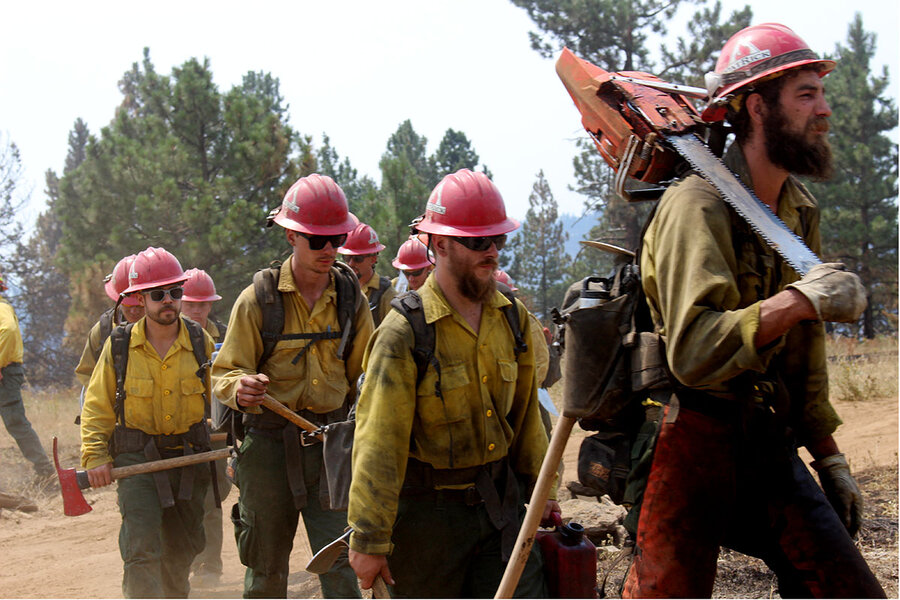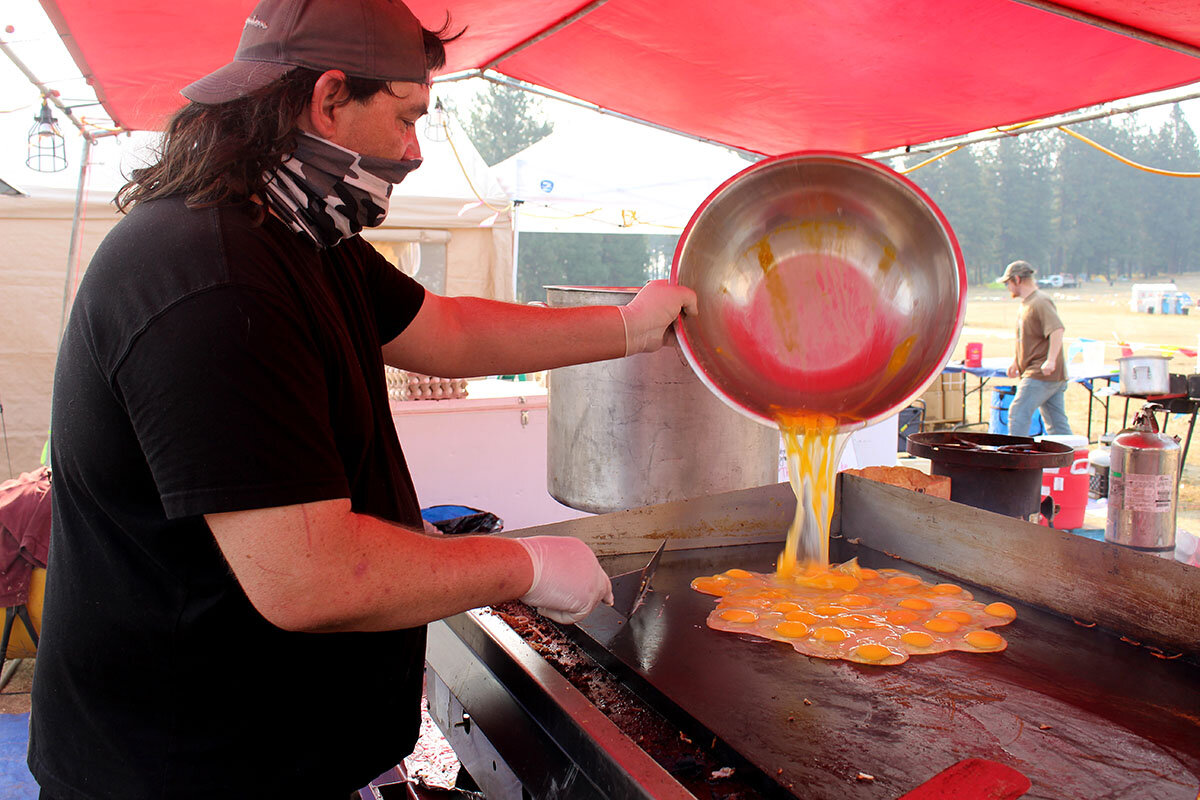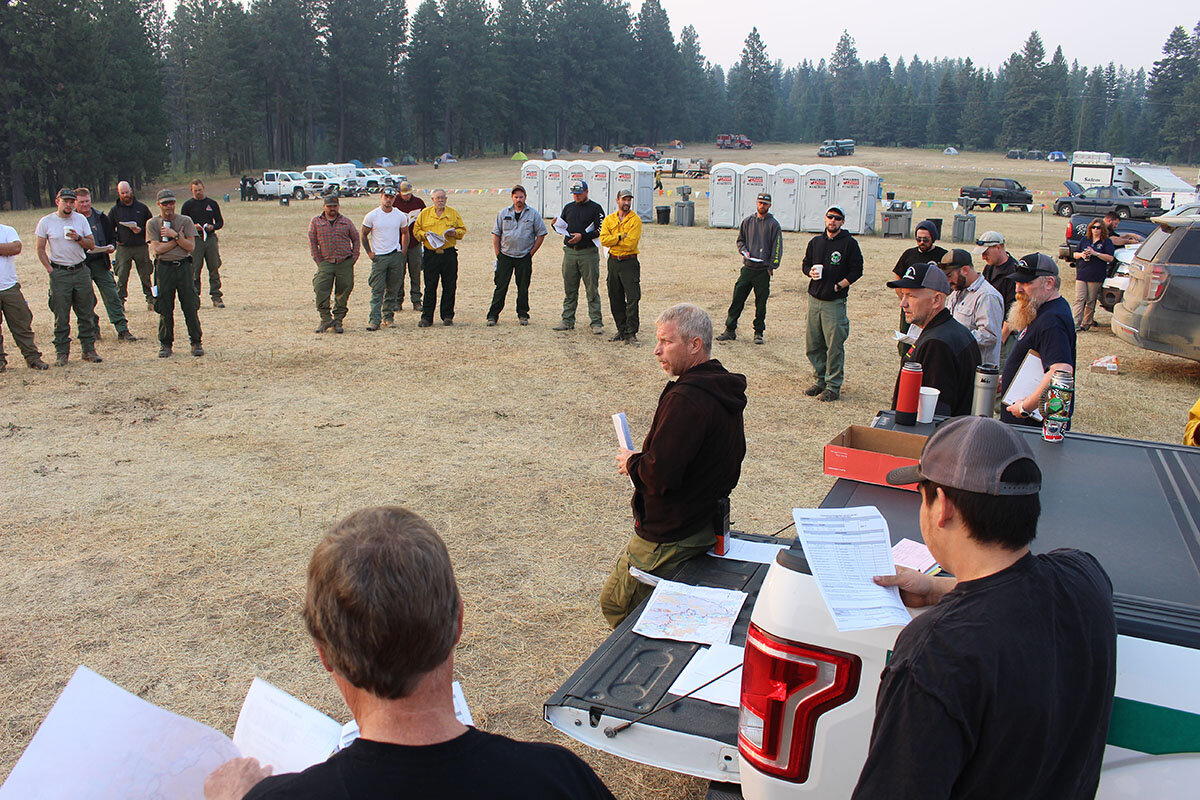Inside a wildfire response camp: Smoke, devotion, and fried chicken
Loading...
| SILVER LAKE, Ore.
Darren Ballentine thinks he knows what it takes to successfully fight a huge wildfire, and he can provide it: meatloaf.
“Good food and good morale make for a safe fire,” says Mr. Ballentine, who is in charge of feeding about 1,200 firefighters at the Oregon Bootleg Fire, which for two weeks was the largest in a swarm of wildfires in the West. “They love the meals like they would get at home.”
Tens of thousands of men and women are fighting the West’s wildfires. Mr. Ballentine, the food supply officer at Forward Operating Base ZX on the north side of the Bootleg Fire, is part of the army that provides the logistics, food, sleeping, and even showers for the firefighters. They are the machinery behind the scenes.
Why We Wrote This
Amid wildfires of historic scale, the efforts to respond are monumental, yet often go unseen. Meet the firefighting crews and support teams on the front lines of large Western blazes.
President Joe Biden recently has expressed concern for that machine. “Our resources are already being stretched to keep up. We need more help,” he told Western governors July 30. The ranks have been weakened by exhaustion from the pace of fires, concern over COVID-19, and the sapping demands of the work in a tinderbox of heat and drought.
The firefighting effort is made up of thousands of volunteers who give up their summers for the prospect of modest pay, unforgettable camaraderie, and dangerous but purposeful work. They get mobilized on short notice to a strange, hot, and dusty place, and create mini-cities in two days to fight fast wildfires. An estimated 15,000 federal firefighters and even more state and local personnel and contractors are in constant choreography. Whole crews are turned over every 14 days or so to provide rest, and numbers on the ground are shuffled daily as fires sputter low in some areas and leap ahead in others.
Behind the front lines is an infrastructure that must respond in lockstep: Encampments of thousands sprout within 48 hours, providing hot meals, tents, medical care, showers, watering stations, communications, and pay vouchers for everyone involved. All the personnel must be accounted for, monitored for their time on the line, and another man or woman must be ready to step in when a team shifts out of the front.
“It’s all in motion every day, every hour,” says Jessica Gardetto at the National Interagency Fire Center in Boise, Idaho. The federal command center on a 55-acre campus in Boise shuffles people and resources – everything from huge air tankers to banks of portable toilets – to and from fires, operating 24 hours a day. “Hotshot” parachute teams depart from the adjacent airport in Boise, helicopters flutter off, and the chiefs of the top federal firefighting agencies huddle twice daily amid maps to shift battle plans.
“It’s a constant chess-piece exercise,” says Ms. Gardetto. The operation has cost the federal government about $2 billion this year alone, and millions more from state and local budgets.
Those on the ground reflect Mr. Biden’s worries. “There are shortages nationwide. We don’t have enough people, says Alysa Johnson, the logistics officer of the Oregon camp, who hustled down from a salmon stream near Fairbanks, Alaska. Many of her requests for additional staff are met with a bureaucratic reply: UTF – unable to fill.
“We just make do,” she says.
Setting plans, one day at a time
It’s 6:30 a.m. at a firefighting camp in southern Idaho, hundreds of miles from the Bootleg Fire. The air smells charred and dusty as the sun climbs behind a high gauze of smoke. About 40 firefighters stand in a rough circle in an open field to hear fire boss Brian Plume and his team outline the plan of attack and repeat their daily liturgy: Stay safe.
“Everybody saw trees and heard trees fall yesterday,” says safety officer Jeff Handel of dead or weakened “snags” that can fall on firefighters focused on the ground. “Look for those snags. Get rid of them.”
The men and women stand hands-in-pockets, wearing heavy boots and smoky clothes. Some wear T-shirts from previous fire campaigns. They are battling the Snake River Complex Fire in the steep Craig Mountains, where more than 100,000 acres have burned.
There is little glamour to the work. The firefighters and their support corps sleep in tents in a shadeless field, work from dawn until late at night, grab a hot meal, and collapse until they are trucked back to the fire tomorrow. On the line, much of the work is done by hand, crude reshaping of ground and vegetation to clear a fire boundary. Those behind in camp scurry for resources to keep the army moving. But most say they want to be nowhere else.
Lewis Holt is working his first year as a firefighter trainee. He knows the land. He is from the local Nez Perce tribe.
“This is my backyard,” he says of the stretch of scrubby hills. He says he appreciates the outsiders who converged on this fire. “I really enjoy them taking care of the land. It’s an honor having them here and helping.”
Wide-ranging backgrounds
The battle against this season’s fierce fires is being done by those people who step forward. They are paid, though often not well. It has dangers. But each has said yes, agreed to an assignment that will take them away from homes and families.
They are diverse: college kids and Army vets, retirees and city firefighters on “vacation.” They are ex-Boy Scouts, cops, people who have served time in prisons, managers, clerks, and ski bums. They are wives and husbands and some drifters. Many are in families in which wildfire fighting is a tradition. In conversations, they say they share the satisfaction of doing hard work for a good cause.
“It’s in their blood. These people are firefighters,” says Ray Miller, who was dispatched to the Snake River Complex Fire from Needmore, Pennsylvania.
“This is the first time we’ve been sent west of the Mississippi,” says John Wambaugh, a former district forester from Potter County in Pennsylvania, who abandoned his retirement garden to help drive two trucks and a crew to Idaho. Firefighting crews often move as a team, but blend with ever-shifting reinforcements.
Mickey Myers, from Twin Falls, Idaho, was added to the Pennsylvanians’ team. He admits he does not see his two small children at home much during the summer – “I call them whenever I have cell connection.”
“My parents and family are always scared for me,” says Mr. Myers, who notes that he turned 24 on the fire line. “But I tell them this is what I was meant to do. I enjoy the heck out of the job. It gives me a sense of purpose.”
Wandering over from a nearby tent, Phillip Foster says he will be riding a water truck today, then straining to tug 200 feet of hose into the heat to spray flare-ups and hot spots. It is hard and dirty – a lot different from his life as “ski coach Phil” – his alias on the winter slopes in Colorado, he says with a grin.
“I’ve done a lot of fun things like that,” he says of his ski instructor’s job. “But I was a Boy Scout. I always thought that was not enough. I wanted to do more for people.”
He is on a crew headed by engine boss Luke White, from Pensacola, a compact man who works for the Florida Forest Service. Mr. White succinctly surveys his new workplace: “Lot more hills. Lot less snakes.”
“They are ready to go”
Parked on the edge of the camp is a big red firetruck, unusual among the dusty brown backcountry vehicles. Eric Smith rode the truck here from Benson, Arizona, for a private firefighting company.
At age 52, Mr. Smith says he is an old-timer on his fire crew, and says he will feel it today when he hikes 7 miles into the fire perimeter as part of a hand crew, lugging a 50-pound pack. But he says he is glad to be here.
“I started out fighting fires from a state prison,” he says. He jumped at doing the same work when he was released three years ago. “’This really helped change my life,” he says. “That was my first prison term, and I wanted it to be my last one.”
His engine boss, Peter Munro, says his Sundance Fire company welcomes people with prison records for the firefighting work. “They are usually good. They have their head straight, and they are ready to go,” he says.
The third member of their team, Rayna Hansen, says she discovered a passion for the work. “I didn’t like studying much,” she says. “This was the first thing that ever intrigued me. I found out about wildlands and found out I loved it. This has become my life’s goal.”
There are not too many women on the fire lines, but she shrugs it off. “If you’re OK with being dirty, and you don’t mind kicking back with the boys, it’s fine,” she says.
Showers, food, and encouragement
As the firefighters rumble off in trucks toward the fire line, Jeffrey Dixon, the base manager or “camp boss,” contemplates the preparations for the evening. Mr. Dixon, a cheerful veteran of 35 years of firefighting, is here from Anchorage, Alaska. The behind-the-scenes work is crucial, he says.
“The first thing firefighters look for when they come back is communication, food, and showers,” he says.
Pleasing a weary crew with communal food is not always successful, he admits. But he meets complaints with good-natured razz. “Hey, you’re not paying for this,” he tells them. “You get more meals than you get at home; you get free clothes, free food, got a job, got a free airplane ride. And you’re getting to see America. You are living the dream!”
The mobilization has come a long way since they went to a fire with “bluejeans, one radio, and some MREs” – excess meals-ready-to-eat from the military, he says.
Ashley Melanson is proof of that. She arrived from Spokane, Washington, at the forward base with two long trailers of showers. Each night and morning, there is a line for an enclosed 10-minute shower. Ms. Melanson’s crew works in between each use to keep the showers clean. She is determined to take a few days off in August to get married.
But as a contractor, she figures she will move from fire to fire all summer. Since the reporting visits for this article, for example, firefighters have made progress on both the Snake River Complex and Bootleg fires, while other blazes in the region remain uncontained.
Over at the food tent, cook Jonathan Smith is swirling a huge bowl of eggs to scramble for the second breakfast shift (the support personnel wait for the firefighters to eat first and get back out on the line). Mr. Smith usually works as a cook at the Wayback Café in Lewiston, Idaho, and jumped at the chance to cook in the field when his restaurant got the catering job.
Tonight he will serve nearly 1,200 meals of fried chicken, baked beans, corn, salad, watermelon, and pies. “These guys work hard, and they need to eat.”







